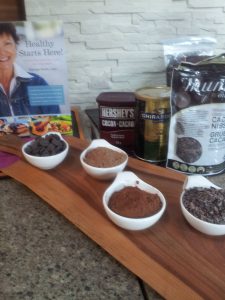You’d have to have been living under a rock for the past several years not to know that dark chocolate is GOOD FOR YOU!
Yeah, we can eat chocolate totally guilt free, or can we?
Well candy companies would like you to think so, but the truth of the matter is that not all chocolate is good for you, and the type that is, you can’t pig out on.
Size matters, portions matter, and so does the brand that you choose.
From Field to Chocolate Factory
That rich dark chocolate bar starts as a pod from the cacao tree. These pods are filled with about 40 white pulp-covered seeds which are the cocoa beans.
The beans are fermented, dried, cleaned, roasted, and then winnowed; a process that separates the shells from the nibs. These nibs are the very essence of chocolate and are the best bang for your antioxidant buck.
The nibs are then ground and milled into a dark brown paste that contains cocoa liquor, not the drinking kind, cocoa butter and cocoa solids. These cocoa solids are processed into cocoa powder. Chocolate manufacturers create their signature flavours blending cocoa powder, cocoa liquor and cocoa butter with ingredients like milk and sugar.

Sounds good so far but:
Cocoa manufacturers’ traditionally ferment the beans to maximize the flavour. They use high heat to roast them and then add an alkaline, to improve the color, texture and flavour. This process is called Dutching. The big problem, is that Dutching reduces the total flavonoid content by two-thirds. And it’s the flavonoids that are responsible for the long term health effects of eating dark chocolate.
Some chocolate manufacturers label their products with the percentage of cocoa used in the finished product. Keep in mind that the percentage of cocoa content isn’t an indicator of flavanol content. That 75% cocoa mass on the label doesn’t mean that there is 75% flavanol content.
What kind of cocoa powder should I buy?
Buy natural cocoa powder. Natural cocoa powder hasn’t been alkalized or Dutched, making it flavanol rich. In Canada Ghirardelli and Hershey’s both make natural cocoa powder, see the picture above. A new company that I discovered today, February 11, 2013 Giddy YoYo does not process their cocoa powder although natural is not on the label. Click here for their website.
What kind of chocolate should I buy?
From a heart health stand point: Buy a brand that you know processes their beans to keep the flavanol content high. Mars, the leader in this area and the maker of Dove chocolate in the USA and Canada, Barry Callebaut, a chocolate company in Europe, Natraceutical, a Spanish firm, or Hershey’s dark and high antioxidant cocoa powder in the USA and Canada. All of these companies process their beans so the flavanol content is high. My personal favourite is Dove Dark. I love the flavour and I know that the flavanol content is high.
This group of health-minded chocolate makers is an ever expanding circle. Count on more brands available in the future.
Health and processing
When it comes to health and chocolate the bottom line is – if it hasn’t been processed to protect those valuable antioxidants it doesn’t matter if the chocolate fairies sprinkled pixie dust on them, you might as well have a flavonol rich apple.
If you’re eating chocolate for your soul – pick your favourite and enjoy.
Thank you very much for this post, Mairlyn. I attended your chocolate talk last year at George Brown and it was very memorable. This post brought back a lot of memories. Now if you’ll excuse me, I need to make some chocolate mousse 😉
I love that chocolate mousse recipe too! Hadn’t made it in a long while – so my family was clamoring for more!
Peace, love and fibre,
mairlyn
Hi – want to make your Triple chocolate brownie cookies – would like to know if can use spelt flour instead of whole wheat flour and is there a subsitute for the wheat germ.
Enjoy watching you on Cityline.
thanks
Hi Diane,
Go ahead and try spelt flour – its higher in protein than regular wheat, might be a tad denser in the long run – and no there isn’t a sub for wheat germ.
Peace, love and fibre,
mairlyn